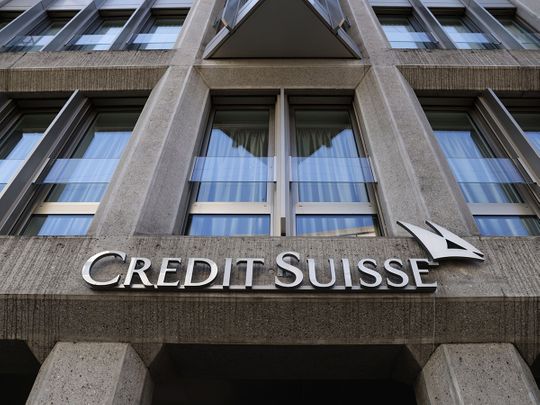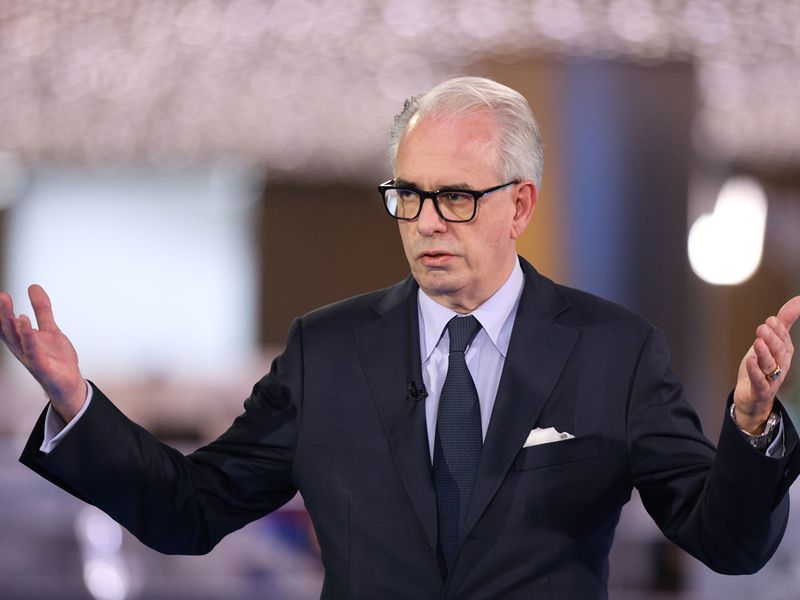
Dubai: Shares of Swiss investment bank Credit Suisse jumped as much as 40 per cent on Thursday after Switzerland’s central bank stepped in to support the lender, triggering a rally in bank stocks across Europe on easing investor concern that the firm’s troubles would trigger a global banking crisis.
A day earlier, the bank was staring into an abyss of uncertainty after its stock crashed 31 per cent just as wider markets were recovering from a battering triggered by the shuttering of California-based Silicon Valley Bank.
One may be keen to draw similarities between the two episodes, but the seeds of Credit Suisse’s slump were sown months earlier. A social media storm in September-October last year about the bank’s poor health – some even pegged it as the next Lehman Brothers – had led to an exodus of the bank’s wealthy depositors, and forced the management to issue a memo that while the bank’s stock price may have been falling, the bank itself had strong capital strength and liquidity.
Then, in early March this year, the bank delayed publishing its 2022 annual report after the US Securities and Exchange Commission (SEC) raised questions about its earlier revision of cash flow statements in 2020 and 2019.
A month earlier, in February, Credit Suisse Group reported that 2022 was its biggest annual loss since the 2008 global financial crisis after rattled clients pulled billions from the bank, and it warned that a further “substantial” loss would come this year.
By then, Switzerland’s second-biggest bank had already begun a major overhaul of its business, cutting costs and jobs to revive its fortunes. It had even raised 4 billion Swiss francs from investors in December.
Chain reaction
A day after SEC’s last-minute intervention, the bank’s shares fell as much as 6.4 per cent in Zurich and its market capitalisation edged close to the $10 billion mark. The bank’s stock had already lost about 9 per cent of its value for the year.
That slump continued for a week until the collapse of SVB sparked concern about broader contagion in the banking industry. That day, Credit Suisse’s five-year credit default swaps jumped as much as 44 basis points to 446 basis points, data showed. (A credit default swap is a financial instrument that allows an investor to swap or offset their credit risk with that of another investor. To swap the risk of default, the lender buys a CDS from another investor who agrees to reimburse them if the borrower defaults.)
A day later, Credit Suisse Group Chairman Axel Lehmann said he is forgoing a payment of 1.5 million Swiss francs ($1.6 million) for his first full year on the job. Lehmann took up the role in January 2022.
‘Material weakness’
When the annual report finally came out, Credit Suisse said it had identified “material weaknesses” in its reporting procedures for the financial years 2022 and 2021, and was adopting a remediation plan.
For the two years “the group’s internal control over financial reporting was not effective”, Credit Suisse said in its annual report. “Management has also accordingly concluded that our disclosure controls and procedures were not effective.”
“PwC, the independent registered public accounting firm that audited the financial statements for the year ended December 31, 2022, included in this annual report, has issued an adverse opinion on the effectiveness of the Group’s internal control over financial reporting as of December 31, 2022,” Credit Suisse added.
The bank also revealed in its report that outflows had continued into March, even after it started a huge campaign to win back client deposits. Clients outflows, at unprecedented levels in early October, hadn’t reversed, though had stabilised at much lower levels.
In November, the bank had announced outflows of about 84 billion Swiss francs ($92 billion) in the core wealth management business.

Collateral damage
When SVB’s collapse hit wider markets, an already weak Credit Suisse stock took a further beating, and its CEO Ulrich Koerner was quick to issue a statement that the bank wasn’t at risk.
“Our credit exposure to SVB in particular is not material,” Koerner said at a Morgan Stanley European Financials Conference.
The bank’s stock had already lost almost a fifth of its value over the past four trading days, as the failure of regional US lenders prompted concerns about banks’ vulnerability to rising interest rates.
A brave face
Even as the Swiss lender slumped to new lows, Koerner sent a positive message to Credit Suisse shareholders: Things were looking up.
The CEO said business was starting to look a little better after the steep losses at the end of last year. While the level wasn’t where he wanted it to be, outflows had moderated significantly, he said. The bank’s restructuring was moving ahead, with headcount slashed by 8 per cent already. And while the collapse of SVB was sending shock waves across the financial system, Credit Suisse’s investors had no reason to worry, he said.
“Earnings momentum is coming back,” Koerner said.

'No assistance needed'
Following news that the government had stepped in to protect SVB depositors, Credit Suisse Chairman Lehmann said government assistance “isn’t a topic” as it sought to shore up confidence among clients, investors and regulators after a series of missteps.
“We have strong capital ratios, a strong balance sheet,” Lehmann said at the Financial Sector Conference in Saudi Arabia. He said it wouldn’t be accurate to compare Credit Suisse’s current problems with the recent collapse of SVB, particularly because the banks are regulated differently.
“We already took the medicine,” he said, adding that the Zurich-based bank is well underway in its restructuring programme.
The same day, the bank’s biggest shareholder ruled out providing more financial assistance, citing regulatory restrictions, causing the stock to shed over 30 per cent in Zurich over multiple days.
“The answer is absolutely not, for many reasons outside the simplest reason which is regulatory and statutory,” Saudi National Bank Chairman Ammar Al Khudairy said when asked if the lender was open to assisting Credit Suisse if there was another call for additional liquidity.
Saudi National Bank, which is 37 per cent owned by the kingdom’s sovereign wealth fund, became Credit Suisse’s biggest shareholder late last year after acquiring a 9.9 per cent stake in the Swiss lender.
Too big to be saved?
In what triggered a further sell-off in the stock, economist Nouriel Roubini warned that Credit Suisse could be too big to bail out.
“The problem is that Credit Suisse, by some standards, might be too big to fail, but also too big to be saved,” Roubini, who’s known as ‘Dr. Doom’, said. Roubini was one of the economists who had predicted the 2007-08 global financial crisis.
Swiss authorities and Credit Suisse, meanwhile, worked on ways to stabilise the bank. In a first salvo to shore up confidence in the battered lender, Switzerland’s central bank and financial regulator said the bank will receive a liquidity backstop if needed, according to a statement. The regulator confirmed Credit Suisse meets the capital and liquidity requirements it imposes on systemically important banks.
$54 billion lifeline
Early Thursday morning, Credit Suisse Group said it had arranged to borrow as much as 50 billion francs ($54 billion) from the Swiss National Bank and offered to repurchase debt in a bid to reverse a collapse in market confidence.
The troubled lender will borrow from a liquidity facility and is making a tender offer to buy back up to three billion francs of dollar- and euro-denominated debt, according to a statement.
The moves - unprecedented at a major Swiss lender since the 2008 financial crisis – were the biggest yet to shore up finances at Credit Suisse.
“These measures demonstrate decisive action to strengthen Credit Suisse as we continue our strategic transformation,” CEO Koerner said in the statement. “My team and I are resolved to move forward rapidly to deliver a simpler and more focused bank built around client needs.”
With inputs from agencies
1870: SKA opens first foreign representative office in New York.
1876: The bank moves into new headquarters on Zurich's Paradeplatz; its first branch outside Zurich opens in Basel nearly three decades later.
1934: First Boston becomes the first publicly held investment bank in the US.
1939: SKA creates Swiss American Corporation (New York) to focus on the underwriting and investment business.
1962: SKA takes over White, Weld and Co AG in Zurich from US investment bank White Weld, and renames it Clariden Finanz AG.
1964: SKA gets a licence as a full-service bank in New York.
1982: SKA becomes the first Swiss bank with a seat on the New York Stock Exchange; CS Holding is set up as a sister company of SKA to hold stakes in industrial companies.
1988: CS Holding buys a 45 per cent stake in First Boston as part of a rescue deal, and renames it CS First Boston; the two had first linked up a decade earlier to operate in the London bond market.
1989: CS Holding becomes SKA group's parent company.
1990: The group takes a controlling stake in CS First Boston and buys Bank Leu, a Swiss private bank.
1993: The group buys Volksbank, Switzerland's fourth-largest bank, and a year later buys Neue Aargauer Bank.
1997: A reorganisation turns CS Holding into Credit Suisse Group and drops the SKA name; it also buys insurer Winterthur, a strategic partner.
1999: The group buys the asset management business of Warburg, Pincus & Co, followed by the purchase of Wall Street firm Donaldson, Lufkin & Jenrette (DLJ) a year later.
2002: A reorganisation creates two units: Credit Suisse Financial Services and Credit Suisse First Boston; two years later it splits into three units by adding Winterthur.
2005: Credit Suisse and CSFB merge and stop using the Credit Suisse First Boston brand name.
2006: The group divests Winterthur to French insurer AXA.
2007: The group merges four private banking units and a securities trading company into Clariden Leu.
2007-08: The bank survives the global financial crisis without needing a state bailout, unlike rival UBS.
2012: The group absorbs Clariden Leu and merges private banking and asset management into one division.
2013: The group buys Morgan Stanley's wealth management businesses in Europe, the Middle East, and Africa.
2015: The group realigns under CEO Tidjane Thiam into three wealth management units supported by two investment banking divisions.
2020: In February, a scandal over the bank's covert surveillance operations leads to Thiam's departure. In March, US investment fund Archegos implodes, saddling Credit Suisse with a $5.5 billion loss. The same month it has to freeze $10 billion in supply chain finance funds linked to insolvent British financier Greensill Capital, which it had marketed to clients as low-risk products.
2021: Antonio Horta-Osorio resigns as chairman less than nine months after joining the bank, after breaching COVID-19 quarantine rules. Alex Lehmann replaces him.
2022: The bank names restructuring expert Ulrich Koerner as CEO to replace Thomas Gottstein and announces another strategic review.
Source: Reuters












